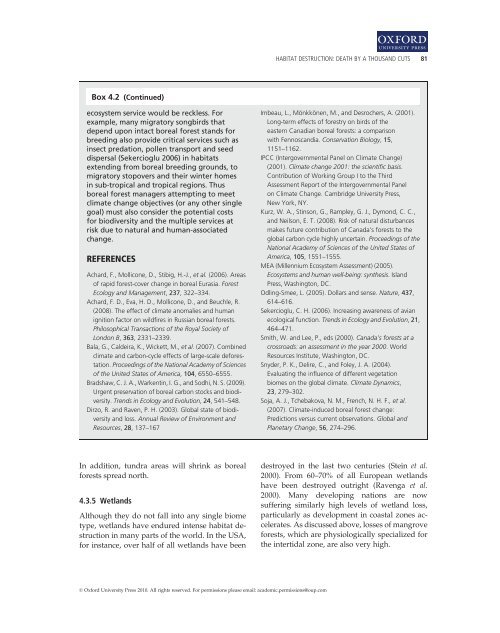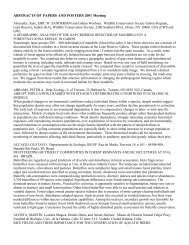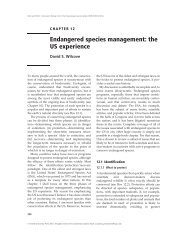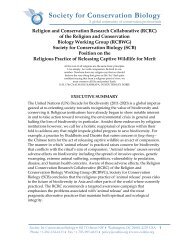Habitat Destruction: Death by a Thousand Cuts - Society for ...
Habitat Destruction: Death by a Thousand Cuts - Society for ...
Habitat Destruction: Death by a Thousand Cuts - Society for ...
- No tags were found...
Create successful ePaper yourself
Turn your PDF publications into a flip-book with our unique Google optimized e-Paper software.
1<br />
HABITAT DESTRUCTION: DEATH BY A THOUSAND CUTS 81<br />
Box 4.2 (Continued)<br />
ecosystem service would be reckless. For<br />
example, many migratory songbirds that<br />
depend upon intact boreal <strong>for</strong>est stands <strong>for</strong><br />
breeding also provide critical services such as<br />
insect predation, pollen transport and seed<br />
dispersal (Sekercioglu 2006) in habitats<br />
extending from boreal breeding grounds, to<br />
migratory stopovers and their winter homes<br />
in sub‐tropical and tropical regions. Thus<br />
boreal <strong>for</strong>est managers attempting to meet<br />
climate change objectives (or any other single<br />
goal) must also consider the potential costs<br />
<strong>for</strong> biodiversity and the multiple services at<br />
risk due to natural and human‐associated<br />
change.<br />
REFERENCES<br />
Achard, F., Mollicone, D., Stibig, H.‐J., et al. (2006). Areas<br />
of rapid <strong>for</strong>est‐cover change in boreal Eurasia. Forest<br />
Ecology and Management, 237, 322–334.<br />
Achard, F. D., Eva, H. D., Mollicone, D., and Beuchle, R.<br />
(2008). The effect of climate anomalies and human<br />
ignition factor on wildfires in Russian boreal <strong>for</strong>ests.<br />
Philosophical Transactions of the Royal <strong>Society</strong> of<br />
London B, 363, 2331–2339.<br />
Bala, G., Caldeira, K., Wickett, M., et al. (2007). Combined<br />
climate and carbon‐cycle effects of large‐scale de<strong>for</strong>estation.<br />
Proceedings of the National Academy of Sciences<br />
of the United States of America, 104, 6550–6555.<br />
Bradshaw, C. J. A., Warkentin, I. G., and Sodhi, N. S. (2009).<br />
Urgent preservation of boreal carbon stocks and biodiversity.<br />
Trends in Ecology and Evolution, 24, 541–548.<br />
Dirzo, R. and Raven, P. H. (2003). Global state of biodiversity<br />
and loss. Annual Review of Environment and<br />
Resources, 28, 137–167<br />
Imbeau, L., Mönkkönen, M., and Desrochers, A. (2001).<br />
Long‐term effects of <strong>for</strong>estry on birds of the<br />
eastern Canadian boreal <strong>for</strong>ests: a comparison<br />
with Fennoscandia. Conservation Biology, 15,<br />
1151–1162.<br />
IPCC (Intergovernmental Panel on Climate Change)<br />
(2001). Climate change 2001: the scientific basis.<br />
Contribution of Working Group I to the Third<br />
Assessment Report of the Intergovernmental Panel<br />
on Climate Change. Cambridge University Press,<br />
New York, NY.<br />
Kurz, W. A., Stinson, G., Rampley, G. J., Dymond, C. C.,<br />
and Neilson, E. T. (2008). Risk of natural disturbances<br />
makes future contribution of Canada’s <strong>for</strong>ests to the<br />
global carbon cycle highly uncertain. Proceedings of the<br />
National Academy of Sciences of the United States of<br />
America, 105, 1551–1555.<br />
MEA (Millennium Ecosystem Assessment) (2005).<br />
Ecosystems and human well‐being: synthesis. Island<br />
Press, Washington, DC.<br />
Odling‐Smee, L. (2005). Dollars and sense. Nature, 437,<br />
614–616.<br />
Sekercioglu, C. H. (2006). Increasing awareness of avian<br />
ecological function. Trends in Ecology and Evolution, 21,<br />
464–471.<br />
Smith, W. and Lee, P., eds (2000). Canada’s <strong>for</strong>ests at a<br />
crossroads: an assessment in the year 2000. World<br />
Resources Institute, Washington, DC.<br />
Snyder, P. K., Delire, C., and Foley, J. A. (2004).<br />
Evaluating the influence of different vegetation<br />
biomes on the global climate. Climate Dynamics,<br />
23, 279–302.<br />
Soja, A. J., Tchebakova, N. M., French, N. H. F., et al.<br />
(2007). Climate‐induced boreal <strong>for</strong>est change:<br />
Predictions versus current observations. Global and<br />
Planetary Change, 56, 274–296.<br />
In addition, tundra areas will shrink as boreal<br />
<strong>for</strong>ests spread north.<br />
4.3.5 Wetlands<br />
Although they do not fall into any single biome<br />
type, wetlands have endured intense habitat destruction<br />
in many parts of the world. In the USA,<br />
<strong>for</strong> instance, over half of all wetlands have been<br />
destroyed in the last two centuries (Stein et al.<br />
2000). From 60–70% of all European wetlands<br />
have been destroyed outright (Ravenga et al.<br />
2000). Many developing nations are now<br />
suffering similarly high levels of wetland loss,<br />
particularly as development in coastal zones accelerates.<br />
As discussed above, losses of mangrove<br />
<strong>for</strong>ests, which are physiologically specialized <strong>for</strong><br />
the intertidal zone, are also very high.<br />
© Ox<strong>for</strong>d University Press 2010. All rights reserved. For permissions please email: academic.permissions@oup.com






